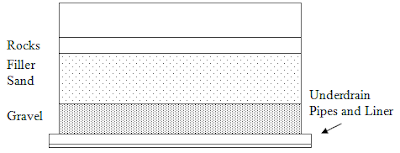Intermittent Sand Filters are largely used to treat and polish the wastewater coming from septic tanks whereby sedimentation already has taken place to remove the most of the solids before being fed to the filter system. It is normally considered to be part of a small treatment facility capable of producing high quality effluent discharge that can be applied for other processes such as irrigation needs and toilet flushing. These small and simple sand filters can be constructed through minor excavation work done and typically depending on requirements, a non-permeable membrane liner has to be laid and present beneath it. Apart from the underdrain network system, among the other major components needed are pumps, orifice shields and simplex panels in order to complete the whole setup.
 These wastewater sand filters are made up of different layers of granular filter media and the overall effectiveness and degree of treatment will largely depend on the size, distribution, selection and type of material and the overall depth including the surface area present. The design of the sand filter will largely depend on the organic loading rate taken as the main criteria. One thing to note is that unlike conventional filter system, this is actually a low-energy filtration process whereby there is no pump needed to drive it through the filter media except for transportation of course and it will rely mainly on gravity to achieve removal of solids. Thus the system has to be adjusted and made in such a way that intermittent feed is required whereby a small dosing system has to present. The configuration has to be set in order to dose based on a certain allowed frequency time period and a study needs to be carried out to find the optimum rate. Apart from that an orifice also needs to be put in place to limit to feed and lower it to a certain flow rate.
These wastewater sand filters are made up of different layers of granular filter media and the overall effectiveness and degree of treatment will largely depend on the size, distribution, selection and type of material and the overall depth including the surface area present. The design of the sand filter will largely depend on the organic loading rate taken as the main criteria. One thing to note is that unlike conventional filter system, this is actually a low-energy filtration process whereby there is no pump needed to drive it through the filter media except for transportation of course and it will rely mainly on gravity to achieve removal of solids. Thus the system has to be adjusted and made in such a way that intermittent feed is required whereby a small dosing system has to present. The configuration has to be set in order to dose based on a certain allowed frequency time period and a study needs to be carried out to find the optimum rate. Apart from that an orifice also needs to be put in place to limit to feed and lower it to a certain flow rate.Other aspect that you should consider is that normally wastewater coming out after pretreatment at the septic tank will determine the effectiveness or how long it can last and if solids are still present in high concentration, this will lead to performance degradation. Thus clogging is a potential issue that you will have to deal with if let’s say the upstream process has not been controlled properly. To debunk the myth saying that sand filters actually achieve separation of solid and water clarification through physical means, this is actually not true as one of the major processes mainly relies on biological action with bacteria present in the system to breakdown harmful waste. Thus performance of the sand filter will largely depend on the temperature whereby during winter period, when temperature drops too low, this will render the system completely useless as the biological actions have largely come to a halt. Apart from that, media reaeration will help so that oxygen can always be available for the microbes to survive and degrade the waste efficiently.
One of the advantages that relates to the use of the intermittent sand filter system is that you can expect the repair and maintenance cost to be fairly low compared to the other high-end waste treatment facility. The main reason and justification for this is that since it relies only on gravity to drive the water through the filter media, it will need minimal moving equipment except for the pumps. This will keep cost of operation in check and while manpower requirement is part and parcel of every processes, overall if well managed and controlled all these should not pose a problem at all in the long run. Apart from that the personnel involved in maintenance have to ensure that the septic tanks are always well-maintained to remove the sludge buildup to prevent carry over to the filter.


